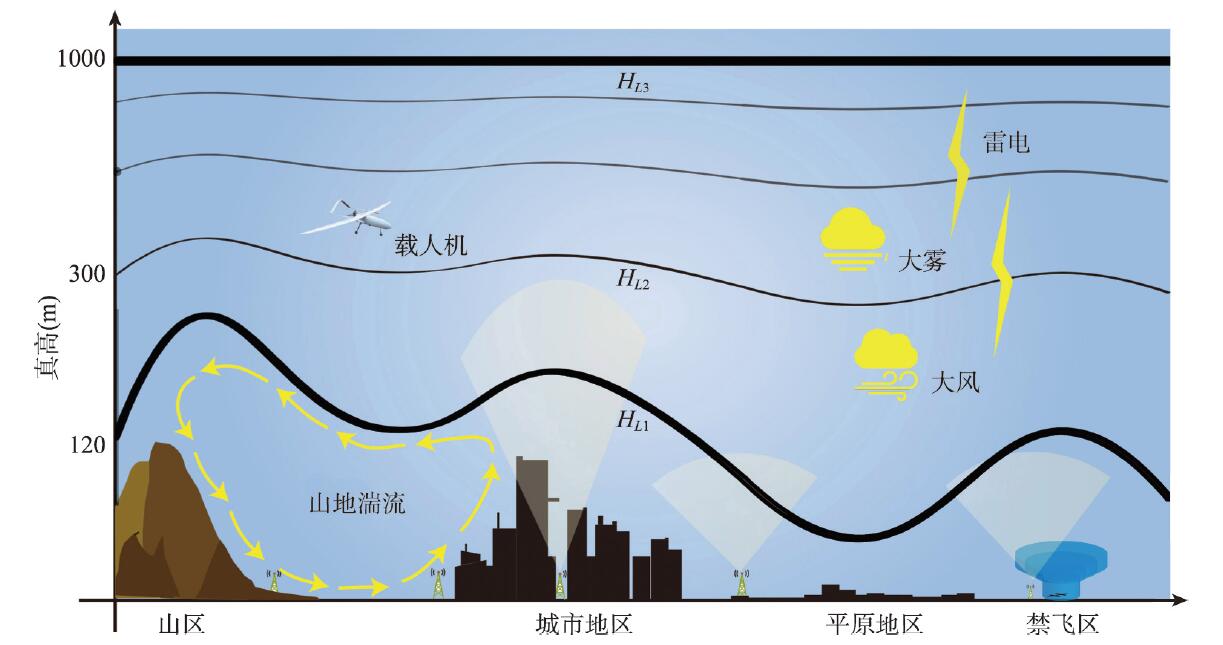

Views on the study of low-altitude airspace resources for UAV applications
Received date: 2021-01-06
Request revised date: 2021-08-18
Online published: 2022-01-25
Supported by
National Key R&D Program of China(2017YFB0503005)
National Natural Science Foundation of China(41971359)
National Natural Science Foundation of China(41771388)
Copyright
With the development of hardware techniques and the decrease in equipment costs, unmanned aerial vehicle (UAV) has been widely applied in various socio-economic fields. However, there have been relatively few studies on low-altitude airspace resources as the operational carrier of UAVs. In this study, from the perspective of geography, the key issues related to the research of low-altitude airspace resources for UAV applications are discussed. Firstly, it is theoretically defined that low-altitude airspace is an important kind of natural resources with natural, social, and economic attributes, which should be included in the national natural resource development and utilization system; Secondly, we review the latest UAV applications based on the low-altitude airspace resources, categorize their constraints to utilize resources from natural and social aspects, and point out that the intervention of geography will speed up the development and utilization process of low-altitude airspace resources. Finally, this paper constructs the low-altitude airspace resource measurement index composed of three categories and nine sub-categories, and proposes four basic principles of low-altitude airspace resource measurement of "non-conflict utilization of resources, safety guarantee, benefit priority, and fairness", and thus forming a theoretical model of low-altitude airspace resource measurement with the three basic elements of national scope (S), true height (H) and time (t). This paper explores and discusses the low-altitude airspace resources from the perspective of geography, which will promote the interdisciplinarity of geography and aviation to some extent and the sustainable utilization of low-altitude airspace resources.

Key words: UAV; low-altitude airspace; resources exploitation; resources quantity; geography
LIAO Xiaohan , HUANG Yaohuan , XU Chenchen . Views on the study of low-altitude airspace resources for UAV applications[J]. Acta Geographica Sinica, 2021 , 76(11) : 2607 -2620 . DOI: 10.11821/dlxb202111001
表1 无人机应用领域分类表Tab. 1 Category of UAV application |
| 无人机应用分类 | 应用领域 | 具体应用场景举例 |
|---|---|---|
| 民用消费级 | 娱乐消费 | 个人航拍、影视航拍、遥控玩具、飞行/灯光表演,等 |
| 民用工业级 | 农林植保 | 农药喷洒、辅助授粉、森林灭火、农林病虫害监测,等 |
| 安防 | 公安巡逻、消防巡逻、交通巡逻、灾情检查、指挥调度、应急救援,等 | |
| 自动巡检 | 电力巡检、石油管线巡检、其他线路巡检,等 | |
| 水利气象环保 | 人工降雨、防洪抗旱、大气取样、企业偷排、入河海排污口/固废/岸线开发排查、生态环境监测、生态环境辅助执法,等 | |
| 测绘勘探 | 资源勘探、城市规划、地图测绘,等 | |
| 科教文体 | 教学、航拍测试、极端环境科学数据获取、科学研究、竞速比赛,等 | |
| 物流运输 | 货物运输、精准投递,等 | |
| 军事和航天级 | - | - |
表2 低空空域资源测度指标体系Tab. 2 Indicators of low-altitude airspace resources quantity measurement |
| 资源属性 | 指标项 | 隶属指标 |
|---|---|---|
| 自然属性 | 时空体基本三要素 | 时间(t)、国土范围(S)、真高(H) |
| 空间体积影响要素 | 地形(DEM)、下垫面状态(DSM) | |
| 地表飞行影响要素 | 地形起伏度、地表粗糙度 | |
| 气候影响要素 | 风速、降水、气压、闪电频次等 | |
| 极端灾害限制要素 | 洪涝、火灾、地震、海啸等 | |
| 社会属性 | 知识技术要素 | 无人机技术、低空交通服务技术等 |
| 资源公共性要素 | 国家安全、行政管理法规制度 | |
| 社会生活公平要素 | 公共安全性、噪声影响、大气污染影响等 | |
| 经济属性 | 经济价值 | 交通密度 |
| [1] |
[孙鸿烈, 成升魁, 封志明. 60年来的资源科学: 从自然资源综合考察到资源科学综合研究. 自然资源学报, 2010, 25(9):1414-1423.]
|
| [2] |
[孙鸿烈, 封志明. 资源科学研究的现在与未来. 资源科学, 1998, 20(1):3-12.]
|
| [3] |
[丰宗旭, 高文明. 空域特性及空域管理. 空中交通管理, 2002(5):11-13.]
|
| [4] |
International Civil Aviation Organization. Annex 11 to the Convention on International Civil Aviation: Air Traffic Services. Montreal, 2001. https://www.icao.int
|
| [5] |
[杨勇, 隋东. 我国低空空域改革和通用航空事业发展有关问题的思考. 南京航空航天大学学报(社会科学版), 2010, 12(2):50-53, 57.]
|
| [6] |
[王世锦. 空域分类关键技术及应用研究[D]. 南京: 南京航空航天大学, 2010.]
|
| [7] |
State Air Traffic Control Commission. Regulations on the Administration of the Use of Low-Altitude Airspace (Tentative Standard). 2014. www.ccaonline.cn/news/hot/10274.html
[国家空管委. 低空空域使用管理规定(试行). 2014. www.ccaonline.cn/news/hot/10274.html
|
| [8] |
[陈志杰. 空域管理理论与方法. 北京: 科学出版社, 2011.]
|
| [9] |
[陈志杰. 未来空中交通管制系统发展面临的技术挑战. 指挥信息系统与技术, 2016, 7(6):1-5.]
|
| [10] |
[廖小罕, 许浩. 无人机运行管控技术发展与应用. 北京: 科学出版社, 2020.]
|
| [11] |
[路紫, 杜欣儒. 国外空域资源开发利用的理论基础、方法论变革与实践. 地球科学进展, 2015, 30(11):1260-1267.]
|
| [12] |
[张文驹, 国土资源行政管理的若干应用基础理论问题(上): 自然资源属性分析. 国土资源通讯, 2002(11):52-55.]
|
| [13] |
[卢嘉瑞. 空间资源的开发与利用. 中国社会科学, 1992(5):83-94.]
|
| [14] |
[刘悦翠, 张慧霞. 资源的持续性. 西北林学院学报, 2004, 19(2):142-145.]
|
| [15] |
[王天雁, 葛少芸. 公共物品供给视角下自然资源国家所有权的限制. 深圳大学学报(人文社会科学版), 2015, 32(3):136-143.]
|
| [16] |
[李昌庚. 国家所有权理论拷辨. 政治与法律, 2011(12):97-110.]
|
| [17] |
[王利明. 物权法研究(上卷). 北京: 中国人民大学出版社, 2007: 506, 508.]
|
| [18] |
[蔡守秋. 论公众共用物的法律保护. 河北法学, 2012, 30(4):11-26.]
|
| [19] |
[徐生钰. 城市地下空间经济学. 北京: 经济科学出版社, 2014: 113-119.]
|
| [20] |
[朱一中, 夏军. 论水权的性质及构成. 地理科学进展, 2006, 25(1):16-23.]
|
| [21] |
[黄莉, 王直民, 鲍海君, 等. 城市地下空间的资源属性与开发特性分析. 上海国土资源, 2018, 39(2):37-40.]
|
| [22] |
[孟志敏. 水权交易市场: 水资源配置的手段. 中国水利, 2000(12):11-12.]
|
| [23] |
[柏艺琴, 陈新锋. 中国无人机运行数据统计报告. 北京: 中国民航出版社, 2019: 5.]
|
| [24] |
[全权, 李刚, 柏艺琴, 等. 低空无人机交通管理概览与建议. 航空学报, 2020, 41(1):6-34.]
|
| [25] |
FORWARD Inc. UAV Industry Status and Development Trend Report(2018). 2018. https://bg.qianzhan.com/report/detail/1809281520250567.html
[前瞻产业研究院. 2018年无人机行业现状与发展趋势报告. 2018. https://bg.qianzhan.com/report/detail/1809281520250567.html
|
| [26] |
[晏磊, 廖小罕, 周成虎, 等. 中国无人机遥感技术突破与产业发展综述. 地球信息科学学报, 2019, 21(4):476-495.]
|
| [27] |
|
| [28] |
[徐晨晨, 叶虎平, 岳焕印, 等. 城镇化区域无人机低空航路网迭代构建的理论体系与技术路径. 地理学报, 2020, 75(5):917-930.]
|
| [29] |
CAAC. Interim Regulations on Flight Management of Unmanned Aircraft (Draft for Comments). 2018. http://www.caac.gov.cn/HDJL/YJZJ/201801/t20180126_48853.html
[中国民用航空局. 无人驾驶航空器飞行管理暂行条例(征求意见稿). 2018. http://www.caac.gov.cn/HDJL/YJZJ/201801/t20180126_48853.html
|
| [30] |
CAAC. Airspace capacity assessment guidance materials. 2006. http://www.caac.gov.cn/XXGK/XXGK/GFXWJ/201511/t20151102_8122.html
[中国民用航空局. 空域容量评估方法指导材料. 2006. http://www.caac.gov.cn/XXGK/XXGK/GFXWJ/201511/t20151102_8122.html
|
| [31] |
NASA. UTM: Air traffic management for low-altitude drone. 2015. http://www.nasa.gov
|
| [32] |
SESAR. U-Space Blueprint. Belgium: Bietlot Press, 2017: 2-5.
|
| [33] |
|
| [34] |
|
| [35] |
US Department of Transportation Federal Aviation Administration. Unmanned aircraft systems (UAS) traffic management (UTM) conception of operations V2.0. 2020. https://www.aa.gov
|
| [36] |
[张军, 张勰, 张学军. 网络化空中交通管理系统. 国际航空, 2008(10):28-30.]
|
| [37] |
[樊邦奎, 张瑞雨. 无人机系统与人工智能. 武汉大学学报·信息科学版, 2017, 42(11):1523-1529.]
|
| [38] |
[宋关福, 钟耳顺, 周芹, 等. 通用三维GIS场数据模型研究与实践. 测绘地理信息, 2020, 45(2):1-7.]
|
/
| 〈 |
|
〉 |